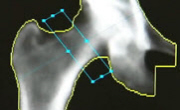칡은 뼈소실 모델인 난소를 적출한 마우스와 랫드에서 뼈형성을 촉진하다고 밝혀진 바 있다. 그러나 뼈파괴세포의 분화와 뼈흡수능에 미치는 칡의 효과와 기전은 아직 밝혀지지 않았다. 그...
http://chineseinput.net/에서 pinyin(병음)방식으로 중국어를 변환할 수 있습니다.
변환된 중국어를 복사하여 사용하시면 됩니다.
- 中文 을 입력하시려면 zhongwen을 입력하시고 space를누르시면됩니다.
- 北京 을 입력하시려면 beijing을 입력하시고 space를 누르시면 됩니다.

파골세포의 분화와 뼈 흡수에 미치는 칡(Pueraria lobata)의 영향 = The Effects of Pueraria lobata on Osteoclast Differentiation and Bone Resorption
한글로보기https://www.riss.kr/link?id=A100281039
- 저자
- 발행기관
- 학술지명
- 권호사항
-
발행연도
2014
-
작성언어
Korean
-
주제어
칡 ; 뼈파괴세포 ; RANKL ; 뼈재형성 ; 골다공증 ; Pueraria lobata ; Osteoclast ; RANKL ; Bone remodeling ; Osteoporosis
-
등재정보
KCI등재
-
자료형태
학술저널
-
수록면
187-196(10쪽)
- 제공처
-
0
상세조회 -
0
다운로드
부가정보
국문 초록 (Abstract)
우선적으로 뼈파괴세포 분화에 억제효과를 확인하기 위하여 마우스에서 분리한 큰포식세포에 칡을 농도별로 처리하여 tartrate-resistant acid phosphatase (TRAP) staining을 시행하였다. 또한 칡이 작용하는 기전을 알아보기 위하여 western blot 분석과 RT-PCR을 시행하였고, 성숙한 뼈파괴세포의 뼈흡수능에 미치는 영향을 알아보고자 hydroxyapatite 플레이트로 실험을 진행하였다.
그 결과, 칡은 뼈파괴세포 분화단계의 필수적인 초기 신호전달경로인 p38, Akt, c-Jun N-terminal kinase (JNK), IκB의 인산화를 억제하였다. 또한 nuclear factor of activated T cells (NFAT)c1과 c-Fos의 비활성화를 유도함으로써 뼈파괴세포와 관련된 유전자인 osteoclast-associated receptor (OSCAR), TRAP, Integrin β3, osteoclast stimulatory transmembrane protein (OC-STAMP), dendritic cell-specific transmem-brane protein (DC-STAMP)의 발현을 저해하였다. 특히, hydroxyapatite로 코팅된 플레이트를 통해서 뼈흡수능을 억제하는 칡의 효과를 확인하였으며, 이와 깊은 연관성을 가지는 유전자인 Cathepsin K의 발현 또한 저해하였다.
이러한 결과를 통하여 뼈파괴세포 분화와 뼈흡수능을 저해하는 칡의 효과와 이와 관련된 분자적 기전에 대하여 규명하였다.
칡은 뼈소실 모델인 난소를 적출한 마우스와 랫드에서 뼈형성을 촉진하다고 밝혀진 바 있다. 그러나 뼈파괴세포의 분화와 뼈흡수능에 미치는 칡의 효과와 기전은 아직 밝혀지지 않았다. 그러므로 본 연구에서는 칡이 recetor activator of nuclear factor-κB ligand (RANKL)과 macrophage colony stimulating factor (M-CSF)로 유도한 뼈파괴세포의 분화에 미치는 효과와 그 기전을 연구하였다.
우선적으로 뼈파괴세포 분화에 억제효과를 확인하기 위하여 마우스에서 분리한 큰포식세포에 칡을 농도별로 처리하여 tartrate-resistant acid phosphatase (TRAP) staining을 시행하였다. 또한 칡이 작용하는 기전을 알아보기 위하여 western blot 분석과 RT-PCR을 시행하였고, 성숙한 뼈파괴세포의 뼈흡수능에 미치는 영향을 알아보고자 hydroxyapatite 플레이트로 실험을 진행하였다.
그 결과, 칡은 뼈파괴세포 분화단계의 필수적인 초기 신호전달경로인 p38, Akt, c-Jun N-terminal kinase (JNK), IκB의 인산화를 억제하였다. 또한 nuclear factor of activated T cells (NFAT)c1과 c-Fos의 비활성화를 유도함으로써 뼈파괴세포와 관련된 유전자인 osteoclast-associated receptor (OSCAR), TRAP, Integrin β3, osteoclast stimulatory transmembrane protein (OC-STAMP), dendritic cell-specific transmem-brane protein (DC-STAMP)의 발현을 저해하였다. 특히, hydroxyapatite로 코팅된 플레이트를 통해서 뼈흡수능을 억제하는 칡의 효과를 확인하였으며, 이와 깊은 연관성을 가지는 유전자인 Cathepsin K의 발현 또한 저해하였다.
이러한 결과를 통하여 뼈파괴세포 분화와 뼈흡수능을 저해하는 칡의 효과와 이와 관련된 분자적 기전에 대하여 규명하였다.
다국어 초록 (Multilingual Abstract)
Previous researches have proved that Pueraria lobata up-regulates bone mineral contents and bone mineral density in bone-loss model, ovariectomized mice and orchidectomized rats. However, the precise effects and mechanisms of Pueraria lobata on osteoc...
Previous researches have proved that Pueraria lobata up-regulates bone mineral contents and bone mineral density in bone-loss model, ovariectomized mice and orchidectomized rats. However, the precise effects and mechanisms of Pueraria lobata on osteoclast differentiation and bone resorbing activity of mature osteoclasts still remains unknown. Therefore, we investigated the effect and mechanism of Pueraria lobata on receptor activator of nuclear factor-κB ligand (RANKL) and macrophage colony stimulation factor (M-CSF)-induced osteoclast differentiation in bone marrow macro-phages (BMMs). First of all, we treated BMMs derived from mice with various concentrations of Pueraria lobata in order to perform screening by tartrate-resistant acid phosphatase (TRAP) staining. Also, we conducted western blotting and RT-PCR for the purpose of verifying the treatment mechanism of Pueraria lobata and lastly, we used hydroxyapatite-coated plate to evaluate the effects of Pueraria lobata on bone resorbing activity of mature osteoclasts. As a result, Pueraria lobata has inhibitory effect on phosphorylation of p38, Akt, c-Jun N-terminal kinase (JNK), and IκB which are essential early signaling pathway of osteoclastogenesis. Also, the inactivation of nuclear factor of activated T cells (NFAT)c1, and c-Fos which is caused by Pueraria lobata is followed by the suppression effects of Pueraria lobata on osteoclastrelated various genes, osteoclast-associated receptor (OSCAR), TRAP, Integrin β3, osteoclast stimulatory transmembrane protein (OC-STAMP), and dendritic cell-specific transmembrane protein (DC-STAMP). Particularly, Pueraria lobata blocks the formation of pit area on hydroxyapatite-coated plate in a dose-dependent manner as well as the mRNA expression of Cathepsin K, which is associated with bone resorbing activity. These results demonstrate the molecular mechanism relating to anti-osteoclastogenesis effect of Pueraria lobata as well as the inhibitory effect of Pueraria lobata on mature osteoclast formation and bone resorbing activity.
동일학술지(권/호) 다른 논문
-
Dextrocardia and Situs Inversus with Incomplete Inversion
- 대한체질인류학회
- Mi-Sun Hur(허미선)
- 2014
- KCI등재
-
- 대한체질인류학회
- 유선경(Sun-Kyoung Yu)
- 2014
- KCI등재
-
사이클로포스파마이드에 인해 퇴축된 흰쥐 가슴샘의 재생과정에서 cDNA꼬리표를 이용한 발현 유전자의 특성 분석
- 대한체질인류학회
- 이건호(Keun-Ho Lee)
- 2014
- KCI등재
-
의과대학 학생의 맨눈해부학 지식에 대한 임상교수의 인식도 조사
- 대한체질인류학회
- 임선주(Sun-Ju Im)
- 2014
- KCI등재




 KCI
KCI DBpia
DBpia



